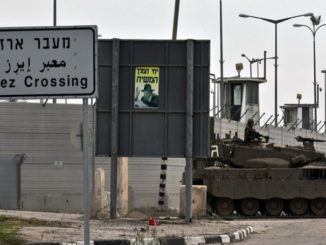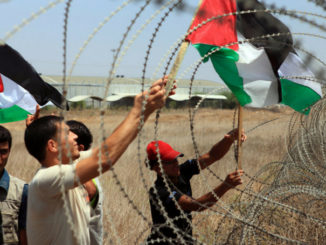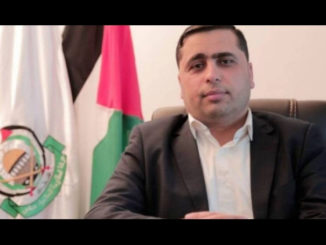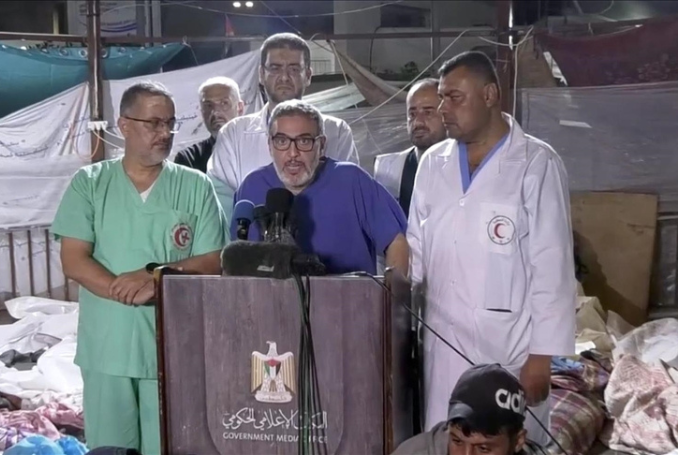
By Nurah Tape – The Palestine Chronicle 
British-Palestinian surgeon, Dr. Ghassan Abu Sittah, shared chilling testimony of the physical injuries and wounds that he witnessed at the Al-Shifa, Al-Ahli and Al-Awda hospitals.
British-Palestinian surgeon, Dr. Ghassan Abu Sittah, has described the situation in the Gaza Strip as “dystopian” with Israel’s main aim being to turn the enclave into “an uninhabitable death world.”
The highly respected plastic and reconstructive surgeon has returned to the UK after spending several weeks caring for the wounded at three hospitals in the besieged enclave. He arrived in Gaza on October 9.
Dr. Abu Sittah told a press conference in London on Monday that the Palestinian health system was clearly “the military objective of this war.”
‘Uninhabitable Death World’
Dr. Abu Sittah said the bombing of the Al-Ahli Baptist Hospital was a litmus test for what Israel planned to do to the rest of the health system.
“After that (bombing), we saw four pediatric hospitals taken out in sequence (including the Nasr, Rantisi, and Muhammad Al Durra hospitals), then they took out the cancer hospitals when the ground invasions began, and they have repeatedly bombed the Indonesian hospital, then eventually Al Awda hospital.”
Dr. Abu Sittah said that there is a pattern in which the aim of this war was to turn Gaza into “an uninhabitable death world so that once there’s some kind of end to the physical hostilities it becomes unbearable for the population.”
“And the aim of ethnic cleansing which was clearly articulated by so many Israeli politicians would happen and continue on after the ceasefire,” he added.
Dr Ghassan Abu-Sitta | Watch LIVE | Press Conference https://t.co/BTxDET58NW
— ICJP (@ICJPalestine) November 27, 2023
Phosphorous Burns
The surgeon shared chilling testimony of the physical injuries and wounds that he witnessed at the Al-Shifa, Al-Ahli and Al-Awda hospitals.
He said most of the initial injuries were blast wounds such as “severe soft tissue trauma, facial traumas, and multiple fractures”.
As time went on, “we saw the introduction of incendiary bombs where patients would have over 40% of their total body surface area burned, with no other injuries.”
By the time Al-Shifa had collapsed, there were over 100 of these patients being treated there.
Thereafter, he said, “we started seeing phosphorus burns” which he was “very familiar with” having treated it in the 2009 Israeli assault on Gaza.
Phosphorus burns right through into the inner core of the body, he explained, and only stops when they have no exposure to oxygen.
Doctors then also started to notice the increased use of fragmentary missiles where the wounds were “very clean cut” with patients “having guillotine amputations in extremely tough parts of the body like the mid-thigh where you have to work through all the muscle, the thigh bone, the femur.”
The surgeon explained that the amputations had “serrated edges, as if what they’d been hit by was a saw.”
🇬🇧🇵🇸🇮🇱🚨‼️ WATCH: Surgeon from Shifa hospital returns to London and explains the white phosphorus burns!
Professor Ghassan Abu Sitta describes how "patients would have over 40% of their total body surface area burnt" pic.twitter.com/aEmyjI7wVF
— Lord Bebo (@MyLordBebo) November 27, 2023
Children with Amputations
Dr. Abu Sittah said half of his operation list were children, and his estimate is that there are now between 700 and 900 children with amputations, and in some cases, multiple limbs had been amputated. In one night, at Al-Ahli Hospital, he had performed amputations on six children.
He said one of the most horrific scenes he witnessed at Al-Shifa Hospital was after the dead and wounded were brought in after an air raid.
“Members of the medical and nursing staff would be running frantically in the emergency department looking at the faces of the wounded and dead to see whether their relatives were among them, in many cases their (own) children were among them.”
Colleagues also paid with their lives, such as Dr. Midhat Saidam, who had not left Al-Shifa hospital for more than a week. When he finally went home, he was killed along with his wife and children in an airstrike. The bodies were recovered 24 hours later from under the rubble.
Sniper Injuries
Dr. Abu Sittah said most hospitals in the Gaza Strip had turned into shelters for the internally displaced.
At Al-Shifa Hospital, there were over 2,000 wounded being housed; the hospital’s bed capacity was only 600. The crisis had reached a point where wounded were being attended to on the floor.
He said by the time the Israeli military had surrounded Al-Shifa, there were 120 wounded children with no surviving families. “Some are too young for us to even know their names,” he added.
Doctors were also starting to treat patients with high-velocity sniper injuries wherein quad copters were used.
“We could hear the distinctive noise that the quad copter makes followed by a single shot.”
He said on one day, “we received 20 patients, some brought in dead.”
“These injuries are distinct”, he explained, “because the size of the inlet and outlet wound is disproportionate…the outlet is bigger than a clenched fist.”
Rest in peace my friend. Tamer was one of the kindest people I had worked with. He was a nurse at the Burns Unit at Shifa hospital. He was killed along with his brother when his house was bombed by the Israelis pic.twitter.com/DVKbTTnMmx
— Ghassan Abu Sitta (@GhassanAbuSitt1) November 25, 2023
Al-Ahli Hospital Bombing
The surgeon was on duty in the operating room of the Al-Ahli Hospital when it was bombed in an airstrike. He described hearing an “almighty whistling sound” followed by a huge explosion.
“The ceiling in the operating room fell on top of us, luckily I wasn’t injured… the ambulances were on fire… the forecourt was full of bodies and parts of bodies.”
Dr. Abu Sittah said “the final straw” came when a mosque in the Sabra neighborhood had been targeted in an air strike. Sixty people were killed, and hundreds wounded.
“That night we operated into the early hours of the following morning. Around 5am, I was informed that we had run out of anesthetic, and the operating rooms would no longer be able to look after the injured.”
He said that was when he made the decision to go to the south, as “I felt that as a surgeon with no access to operating rooms, no morphine, no access to … anesthetic, there was nothing for me to do.”
British surgeon @GhassanAbuSitt1 is in no doubt – the destruction of the healthcare system in Gaza is a deliberate strategy by Israel. pic.twitter.com/siNI0EjPY6
— Saul Staniforth (@SaulStaniforth) November 20, 2023
Dystopian Film
The surgeon said he, along with a group of others, walked for over five hours through what “looked like a scene from a dystopian film.”
“There were bodies everywhere, the sound of Israeli tanks as they were circling and moving into position around Al-Ahli. There was just absolute destruction.”
He said “the pinnacle” was Salah al-Din Street where Israeli soldiers, including snipers, with cameras using facial-recognition technology targeted civilians who passed through. He had seen more than 15 Palestinians to one side who had been arrested, and “had been stripped naked, blindfolded and with their hands behind their backs.”
When he arrived at Nuseirat camp, he realized that the hospitals were unable to take their patients to the operating room.
For the two days spent there, “I was just doing changes of dressing, because there was no ability to operate.”
That was when he made the decision to leave the Gaza Strip, on Day 43.
“Since I left we have discovered lots of colleagues have been killed and taken out of the rubble. Since I left, the Israelis have bombed Al-Awda Hospital, killing three doctors and narrowly killing a fourth.
“The whole of the northern Gaza Strip still has no hospitals functioning in it.”
Dr. Abu Sittah has reportedly agreed to work with UK police to provide eyewitness evidence of Israeli “war crimes” perpetrated over the past few weeks.
“My duty as a doctor is not just to give treatment to my patients, but also to find justice for them,” he told the Anadolu news agency.
(The Palestine Chronicle)
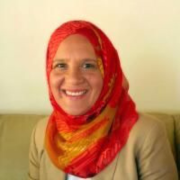
– Nurah Tape is a South Africa-based journalist. She is an editor with The Palestine Chronicle.



